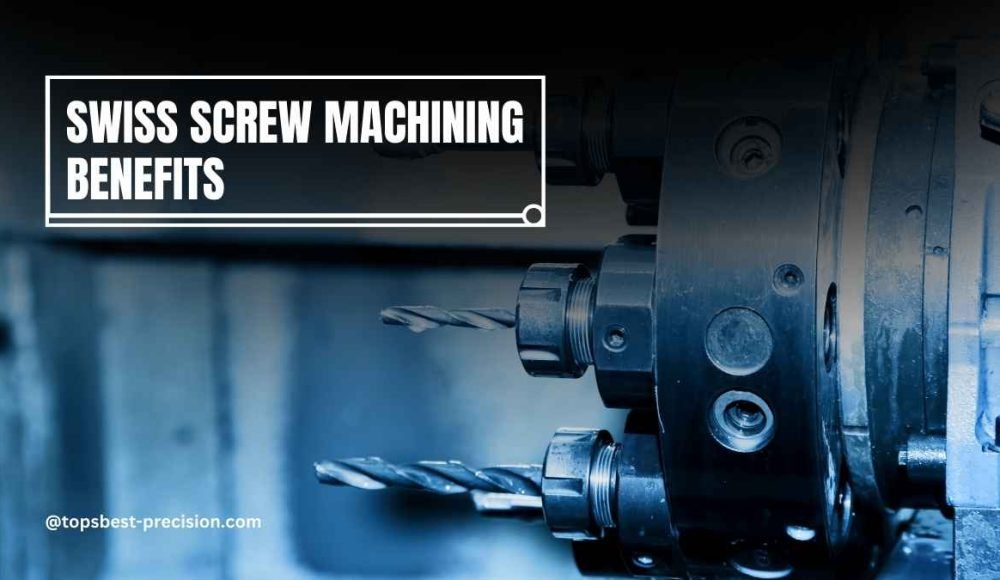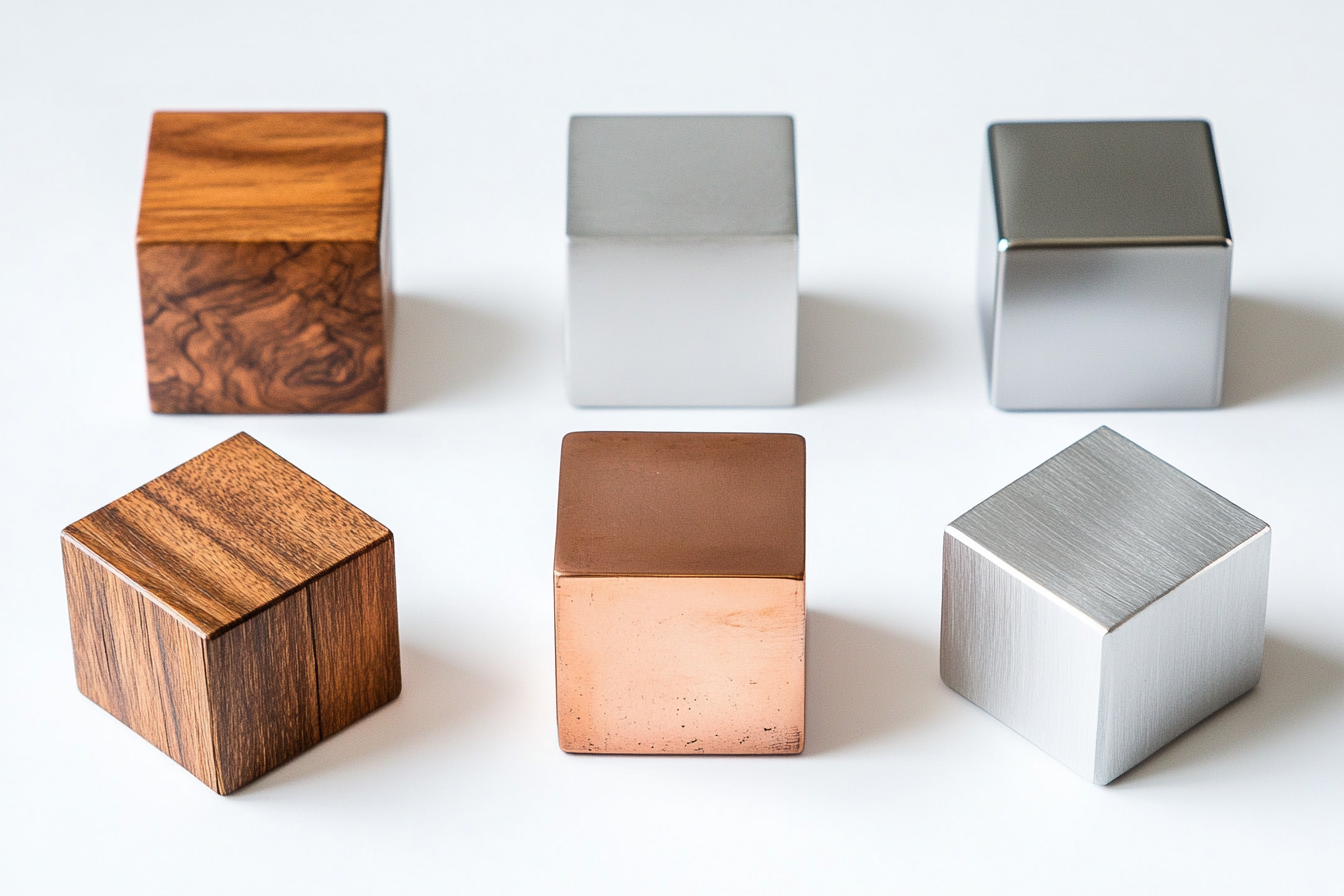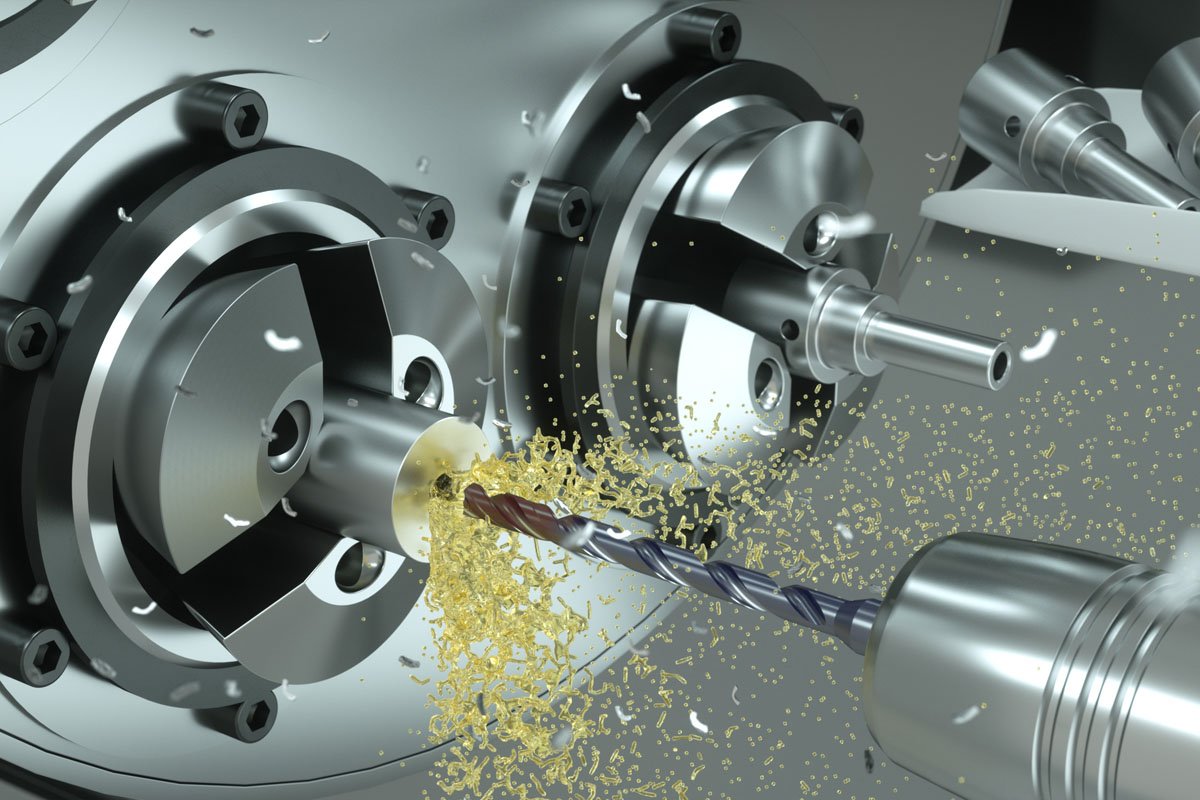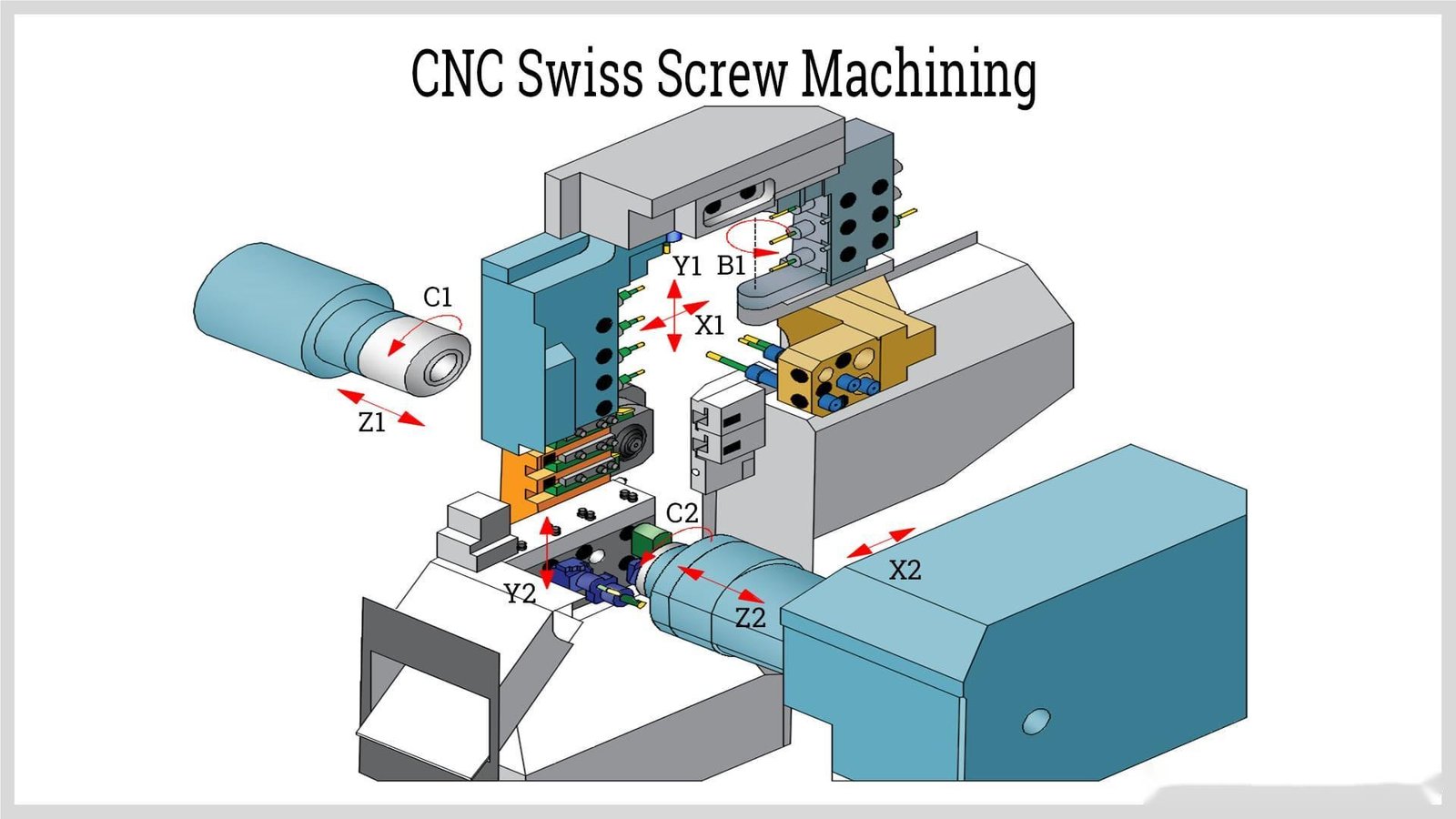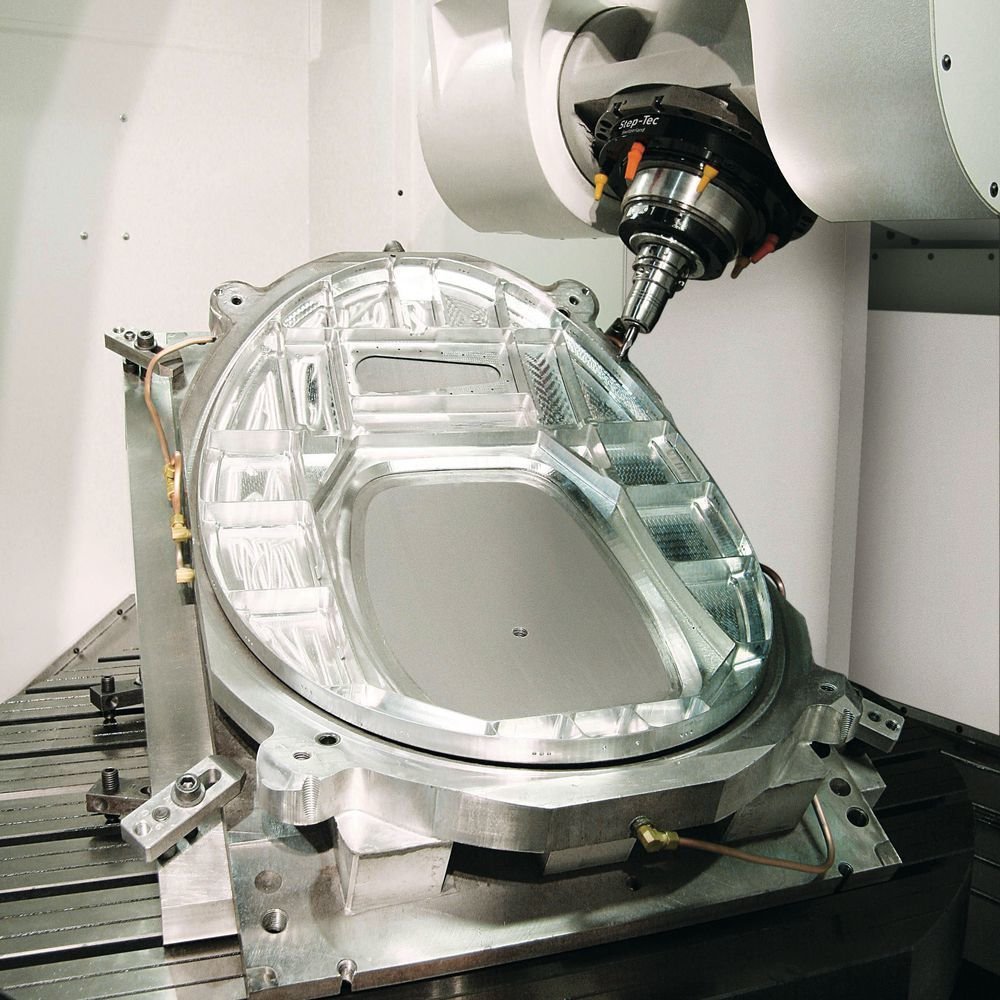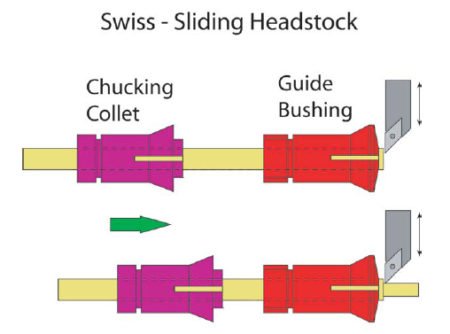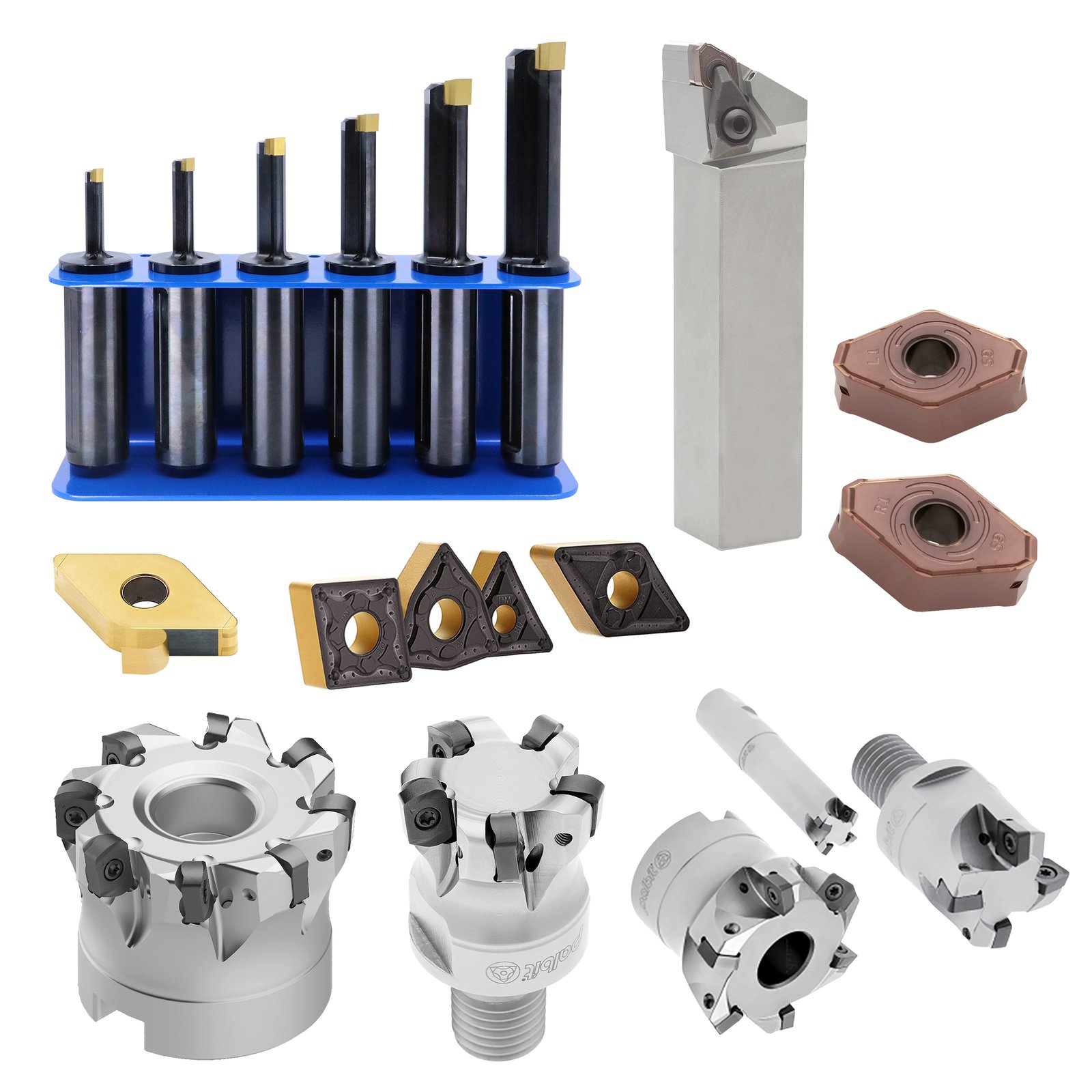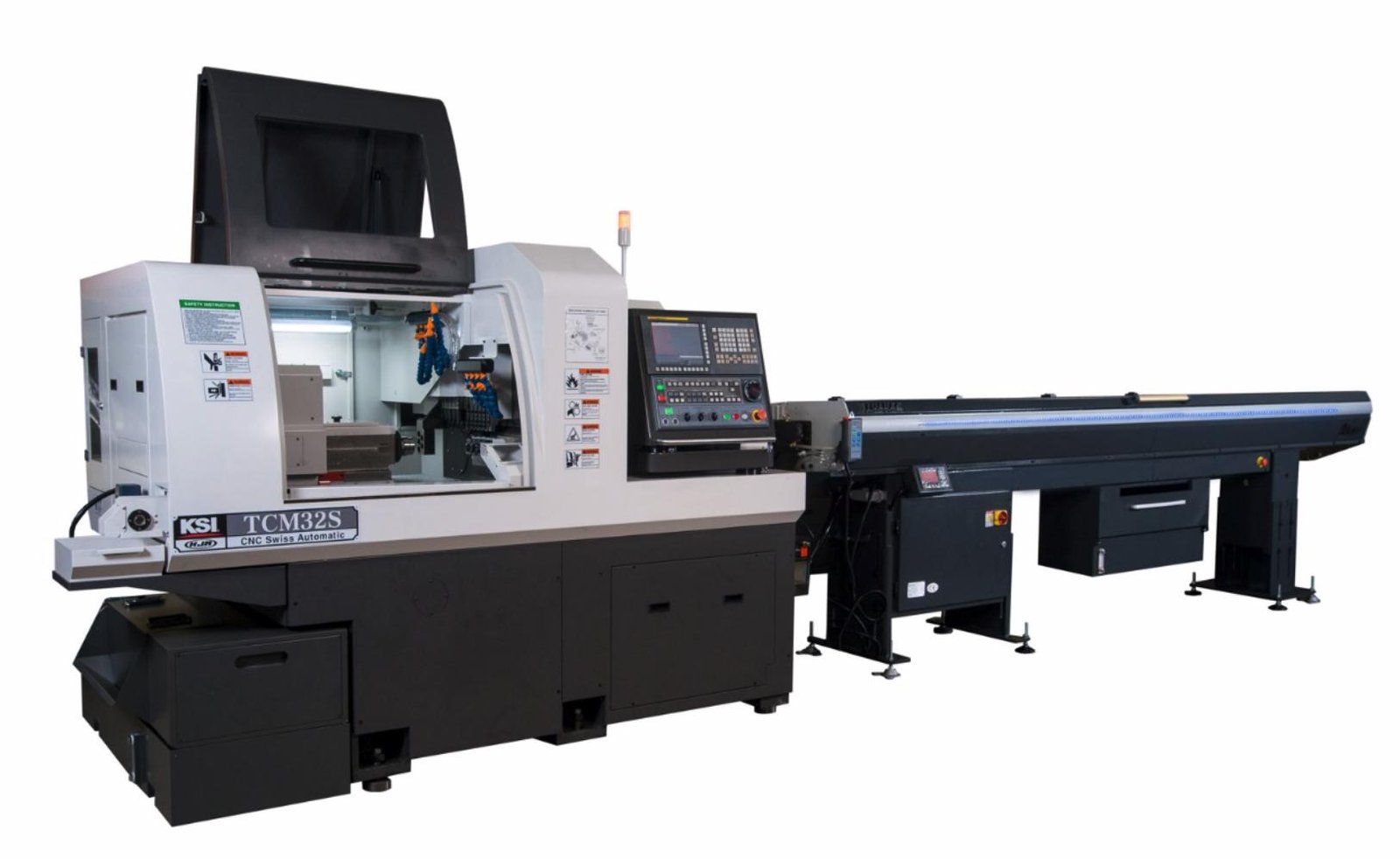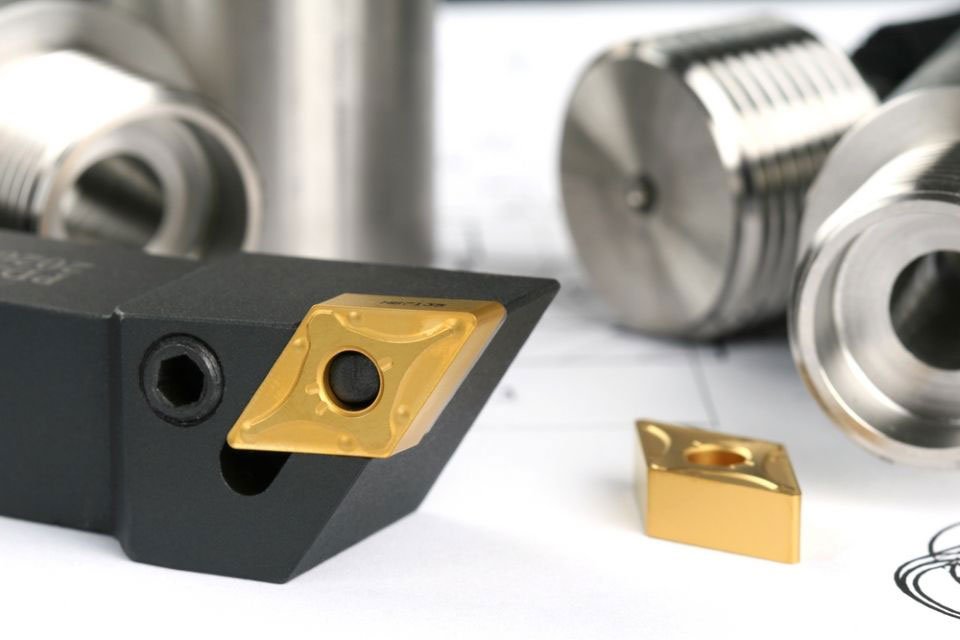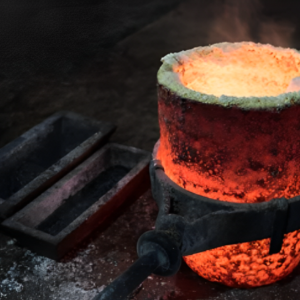Swiss screw machining is one of the most precise and efficient manufacturing techniques used in modern industries. Known for its ability to produce small, intricate components with extreme accuracy, Swiss screw machining is a preferred method in aerospace, 医学, エレクトロニクス, その他の高精度産業.
This article explores everything you need to know about Swiss screw machining, それがどのように機能するかを含む, その利点, とその応用. Whether you’re considering this technology for manufacturing or just curious about its advantages, this guide will provide you with in-depth insights.
How Does a CNC Swiss Screw Machine Work?
Swiss screw machines are a specialized type of CNC lathe designed to manufacture small, 高精度部品. Unlike conventional lathes, which hold a workpiece stationary while the cutting tools move, Swiss machines feed the material through a guide bushing, allowing for more precise and stable machining.
Here’s how the Swiss screw machining process works:
Programming the Component’s Design
The process begins with a CAD (コンピュータ支援設計) model of the part. The design is converted into a CNC (コンピュータ数値制御) program, which dictates how the machine will cut, ドリル, and shape the material.
Loading the Bar Stock
A bar feeder loads long cylindrical rods (bar stock) into the Swiss screw machine. This automated feeding system enables continuous production without frequent reloading, improving efficiency.
Cutting and Drilling
As the bar stock moves through the guide bushing, the cutting tools operate very close to the point where the material is held, reducing vibration and ensuring precise cuts. Multiple tools can work simultaneously, allowing for complex machining in a single setup.
Automatic Part Ejection
Once the machining is complete, the finished part is automatically separated from the bar stock, and the next piece is immediately positioned for machining. This seamless transition speeds up production, making Swiss screw machining ideal for high-volume manufacturing.
🔗 さらに読む: CNC 加工のしくみ
Materials Used in Swiss Screw Machining
Swiss screw machining is compatible with a wide variety of materials, 含む:
- 金属:
- プラスチック:
- ピーク (医療用インプラント)
- PTFE (テフロン)
- ナイロン (自動車 & Industrial components)
🔗 さらに読む: Best Materials for CNC Machining
Benefits of Swiss Screw Machining
Swiss screw machining is one of the most efficient ways to manufacture small, 高精度部品. 航空宇宙分野にいるかどうか, 医学, or electronics industry, this method offers several advantages over traditional machining.
Super High Precision
Swiss screw machines are built for precision. They can cut parts with tolerances as tight as ±0.0002 inches (0.005んん). That means every part comes out exactly the same, which is crucial for industries like medical and aerospace, where even the smallest mistake can be costly.
Unlike conventional lathes, Swiss machines hold the workpiece close to the cutting tool, reducing vibrations and ensuring accuracy. This results in 完璧, repeatable parts 毎回.
Fast and Efficient Production
One of the biggest advantages of Swiss screw machining is スピード. These machines can work non-stop for hours, churning out thousands of identical parts in a short time.
Here’s why it’s so efficient:
✅ Multiple tools can cut the material at the same time
✅ Bar feeder system keeps the machine running continuously
✅ Less operator supervision means lower labor costs
必要に応じて 大量生産, Swiss screw machining is the way to go.
Handles Complex Designs with Ease
Swiss screw machining is perfect for parts with tiny holes, 薄い壁, および詳細な機能 that other machines struggle to produce.
Thanks to CNC (コンピュータ数値制御) プログラミング, you can create カスタム, 複雑なデザイン without worrying about errors. Need a small medical implant or a delicate aerospace component? A Swiss machine can handle it.
Works with a Wide Range of Materials
Swiss machines aren’t just limited to one type of material. They work well with 金属, プラスチック, もっと, 含む:
🔹 ステンレス鋼 – Great for aerospace and medical applications
🔹 アルミニウム – Lightweight and corrosion-resistant
🔹 チタン – Strong and durable for high-performance parts
🔹 真鍮 & 銅 – Excellent for electronics and plumbing
🔹 プラスチック (ナイロン, ピーク, PTFE, 等) – Ideal for lightweight, non-metal components
No matter what material you need, a Swiss screw machine can カット, ドリル, and shape it with precision.
Saves Money by Reducing Waste
Swiss screw machining is highly efficient, meaning less wasted material and lower costs. Since the machine cuts so precisely, there’s minimal scrap. プラス, any leftover material can often be リサイクル for future use.
Less waste = More savings for your business.
Consistent Quality for Every Part
If you’re producing thousands or even millions of parts, consistency is key. Swiss machines guarantee uniformity across all parts, ensuring they meet the exact same specifications every time.
This is especially important in industries like medical and aerospace, where parts must fit together perfectly to function properly.
Great for High-Volume Production
Swiss machines can produce thousands of parts quickly, making them perfect for:
✔ Mass production runs
✔ Bulk manufacturing orders
✔ Large-scale industrial projects
Once a program is set up, the machine can run 24/7 最小限の監督で, allowing businesses to produce parts faster and cheaper.
Less Manual Labor = Lower Costs
Traditional machining methods require constant supervision from operators, which increases labor costs. With Swiss screw machining, the process is 自動化されています, reducing the need for human intervention.
Less manual labor means:
✅ Lower operating costs
✅ Fewer errors
✅ Faster turnaround times
It’s a win-win for manufacturers looking to improve efficiency and cut costs.
Smooth Surface Finishes
Swiss screw machining produces スムーズ, clean finishes that often don’t need additional polishing or refinishing. This is crucial for medical and aerospace parts, where surface imperfections can affect performance.
プラス, if a specific finish is required (陽極酸化またはメッキのような), Swiss-machined parts are already smooth enough to make post-processing easier.
Reduced Downtime and Maintenance
Swiss machines are highly reliable and require minimal maintenance compared to traditional machining tools. Since they operate with less vibration and wear, they last longer and experience fewer breakdowns.
これはつまり:
✅ Less downtime
✅ More parts produced
✅ Lower repair costs
メーカー向け, more uptime means more money in your pocket.
Got it! Here’s your article without bold formatting while keeping all the original content unchanged:
Types of Swiss Screw Machining
Swiss screw machining is an advanced manufacturing technique used to produce small, highly precise parts. But did you know that there are different types of Swiss screw machining? Each type is designed to handle specific tasks, 材料, and production needs.
Automatic Swiss Screw Machining
This is the traditional type of Swiss machining, where a fully automated lathe does all the work.
- Uses cams and mechanical controls
- Great for high-volume production
- Works best for simple parts with standard designs
These machines were widely used before CNC technology became popular. They are still useful today for fast, repetitive production runs with minimal setup time.
CNC Swiss Screw Machining
This is the most advanced type of Swiss machining. It uses computer numerical control (CNC) programming to automate every step of the process.
- Incredibly precise – can reach tolerances of ±0.0002 inches
- Can handle complex geometries and small, 複雑な部品
- Can work with multiple tools at the same time
CNC Swiss machines are perfect for industries like medical, 航空宇宙, そしてエレクトロニクス, where accuracy is everything. Since they are computer-controlled, they can run 24/7 最小限の監督で.
Single-Spindle Swiss Screw Machining
名前が示すように, single-spindle machines use just one spindle to rotate the workpiece.
- Lower cost compared to multi-spindle machines
- Ideal for low-to-medium production runs
- Works well for prototypes and custom parts
Single-spindle Swiss machining is a great choice for small businesses or manufacturers who need precision without mass production.
Multi-Spindle Swiss Screw Machining
Unlike single-spindle machines, multi-spindle Swiss machines have multiple rotating spindles, which means they can work on several parts at once.
- Much faster production than single-spindle machines
- Ideal for large-scale manufacturing
- Reduces production time and increases efficiency
Multi-spindle machines are best for high-volume orders where speed is a priority, such as in automotive, 航空宇宙, および医療産業.
Sliding Headstock Swiss Machining
In this type of machining, the headstock moves back and forth, guiding the material through a guide bushing.
- Reduces vibrations and deflection, making it ultra-precise
- Works well for long, thin parts
- Used in medical and aerospace industries where extreme precision is needed
Sliding headstock machines can handle very tight tolerances, making them ideal for machining small, delicate components like surgical tools or microelectronic parts.
Fixed Headstock Swiss Machining
This is the opposite of sliding headstock machining. この方法では, the workpiece remains fixed, and only the tools move.
- Better for shorter, bulkier parts
- More rigid and stable, ツールの摩耗を削減します
- Works well for medium-precision applications
If you don’t need super tight tolerances, fixed headstock machining can be a cost-effective option while still providing good accuracy.
Hybrid Swiss Machining
Hybrid Swiss machines combine features from different machining types.
- Can switch between sliding headstock and fixed headstock
- Offers versatility – can handle both long and short parts
- Best for companies that manufacture a wide variety of parts
Hybrid machines reduce the need for multiple setups, making them a great all-in-one solution for manufacturers that need flexibility.
Which Type of Swiss Screw Machining is Best for You?
The right type of Swiss screw machining depends on your project needs. Here’s a quick guide to help you choose:
| Machining Type | に最適です | 重要な利点 |
| Automatic Swiss | 単純, 大量生産部品 | Fast production with lower costs |
| CNC Swiss | 複雑な, 高精度部品 | Extreme accuracy and automation |
| Single-Spindle | プロトタイプ, 小さなバッチ | 低コスト, good for custom parts |
| Multi-Spindle | 量産, large-scale manufacturing | Higher speed and efficiency |
| Sliding Headstock | 長さ, thin, 繊細な部品 | Ultra-precise with minimal vibration |
| Fixed Headstock | 短い, bulkier parts | More stable and cost-effective |
| Hybrid Swiss | Various part sizes and complexities | Versatile and reduces setup time |
If you’re making high-precision medical implants, CNC Swiss machining or sliding headstock machining is your best bet. If you need high-volume, 単純な部品, go with multi-spindle or automatic Swiss machining.
比較: Swiss Screw Machining vs. Conventional CNC Machining
| 特徴 | Swiss Screw Machining | Conventional CNC Machining |
| Workpiece Holding | Guide bushing provides stability | Workpiece held at one end |
| 公差 | ±0.0002 inches (0.005んん) | ±0.001 inches (0.025んん) |
| 効率 | Continuous machining with bar feeders | Manual loading/unloading |
| に最適です | 小さい, 複雑な部品 (例えば, 医療用インプラント) | Larger, less intricate parts |
💡 重要なポイント: Swiss machining is ideal for high-precision, small-diameter parts that require tight tolerances and mass production.
Applications of Swiss Screw Machined Parts
Swiss screw machining is widely used across various industries, where precision and efficiency are critical. いくつかの一般的なアプリケーションを次に示します:
航空宇宙産業
Aircraft and spacecraft components must meet strict tolerances to ensure safety and reliability. Swiss screw machining is used to produce:
- Screws and fasteners
- Shafts and couplers
- Connectors and retainer rings
- Structural brackets
Medical and Dental Industry
Swiss machining is crucial in manufacturing medical and dental equipment, as these tools require extreme precision. Common Swiss-machined medical parts include:
- 手術器具
- Catheters and stents
- Dental implants and braces
- MRI scanner components
自動車産業
High-performance vehicles require precision-machined parts for optimal efficiency and durability. Swiss screw machining is used to manufacture:
- Fuel injectors
- バルブコンポーネント
- Brake system parts
- センサーハウジング
Electronics and Telecommunications
As technology continues to advance, the demand for miniature, high-precision electronic components has grown. Swiss screw machining is used to create:
- Circuit board components
- Radio and antenna connectors
- Miniature screws and fasteners
- Precision pins for electrical contacts
Military and Defense Industry
The military sector requires durable, high-performance components that can withstand extreme conditions. Swiss screw machining is used for:
- Firearm components
- Military vehicle parts
- Aerospace defense system components
Food Processing Equipment
Food-grade machinery must be durable, 腐食に強い, and easy to clean. Swiss-machined components in the food industry include:
- Stainless steel mixers
- Conveyor belt components
- OEM machine parts
Machine Tools Used for Swiss Screw Machining
Swiss screw machining is all about precision, and to achieve that, you need the right tools. These machines are designed to create tiny, highly detailed parts with extreme accuracy. But what are the key tools that make Swiss screw machining so effective? それらを分解しましょう.
Swiss-Type CNC Lathe
The heart of the Swiss screw machining process is the Swiss-type CNC lathe. Unlike traditional lathes, Swiss lathes hold the workpiece with a collet and guide it through a bushing, reducing vibration and increasing precision.
なぜそれが重要なのか:
- Allows for tight tolerances (as precise as ±0.0002 inches)
- Reduces deflection in long, thin parts
- Can perform multiple operations in one setup
Swiss-type CNC lathes come in single-spindle そして multi-spindle versions. If you need high-volume production, multi-spindle machines can produce multiple parts at once, making the process much faster.
Guide Bushing
あ guide bushing is a small but critical component that helps stabilize the material as it’s machined. It holds the bar stock close to the cutting tool, which minimizes bending and deflection.
なぜそれが重要なのか:
- Improves accuracy by keeping the workpiece steady
- Reduces vibration, leading to smoother finishes
- Essential for machining long, thin parts
Without a guide bushing, small parts could bend or break, making it impossible to achieve precise results.
Rotary Tools (フライス加工 & Drilling Attachments)
Swiss screw machines don’t just turn parts—they also mill and drill. Rotary tools help add features like holes, スロット, and threads to the workpiece.
なぜそれが重要なのか:
- Allows for complex shapes and features
- Reduces the need for secondary operations
- Enhances efficiency by performing multiple tasks in one cycle
These attachments make Swiss machines highly versatile, enabling them to create everything from 医療用インプラント に aerospace connectors.
Live Tooling
Unlike regular lathes, Swiss screw machines can have live tooling, which means some tools can rotate while cutting. This is especially useful for cross-drilling, たたく, and other secondary machining operations.
なぜそれが重要なのか:
- Increases machining capabilities
- Reduces setup time
- Eliminates the need for additional machines
Live tooling allows manufacturers to complete parts in one go, rather than moving them to another machine for secondary operations.
高速スピンドル
の スピンドル is what holds and rotates the workpiece. In Swiss machining, high-speed spindles are essential because they allow for ultra-fast cutting while maintaining accuracy.
なぜそれが重要なのか:
- Can reach speeds of up to 10,000 回転数
- Enables smooth cutting for small and delicate parts
- Helps achieve tight tolerances
High-speed spindles are especially useful when machining ステンレス鋼, チタン, and other tough materials.
Bar Feeder
Swiss screw machines are designed for continuous production, which is why they use a bar feeder to automatically load material into the machine.
なぜそれが重要なのか:
- Keeps production running without manual intervention
- Reduces downtime and increases efficiency
- Ideal for high-volume production
あ good bar feeder can hold multiple bars of material, meaning the machine can run for hours or even days without needing to be refilled.
冷却システム
With Swiss screw machining’s high-speed cutting, ある クーラントシステム is needed to prevent overheating and extend tool life.
なぜそれが重要なのか:
- Keeps the cutting tools and workpiece cool
- Prevents tool wear and material damage
- スムーズさを確保, burr-free finishes
Using the right coolant also helps reduce friction, improving the overall efficiency of the machining process.
Tool Holders & Cutting Inserts
Swiss screw machines use specialized tool holders and inserts that allow for extreme precision and long tool life. These cutting tools can be changed out quickly, reducing downtime.
なぜそれが重要なのか:
- Helps maintain consistent cutting quality
- Allows for quick tool changes to keep production moving
- Reduces waste and improves efficiency
例えば, carbide inserts are commonly used because they stay sharp longer, especially when cutting tough materials like titanium and stainless steel.
Why Choose CNC Swiss Screw Machining?
Swiss screw machining stands out for its:
✔ Unmatched precision – Capable of producing intricate parts with tight tolerances
✔ スケーラビリティ – Suitable for both small prototype runs and mass production
✔ オートメーション – Runs for long hours with minimal human intervention
✔ High material efficiency – Less waste, more sustainability
✔ Versatile material compatibility – Works with metals and plastics
Swiss screw machining is ideal for manufacturers who need high-precision, high-volume, and cost-effective コンポーネント.
Cost Breakdown of Swiss Screw Machining
| 要素 | Impact on Cost |
| 材料 | Titanium costs more than aluminum |
| 複雑 | より複雑なデザイン increase cost |
| Order Volume | Larger batches reduce cost per part |
💡 Typical Cost Range:
- Simple parts:$1 – $5 per unit
- Medium complexity:$5 – $15 per unit
- 高精度部品:$20 – $100 per unit
🔗 さらに読む: CNC Machining Cost Breakdown
結論
Swiss screw machining is a revolutionary process that has transformed industries requiring high-precision components. Its 効率, 精度, and ability to handle complex designs make it an essential tool in modern manufacturing.
If you’re looking for custom Swiss-machined parts, トップス 精度 offers top-notch services with high-quality materials and precision craftsmanship. Contact us today to learn how we can bring your designs to life!

